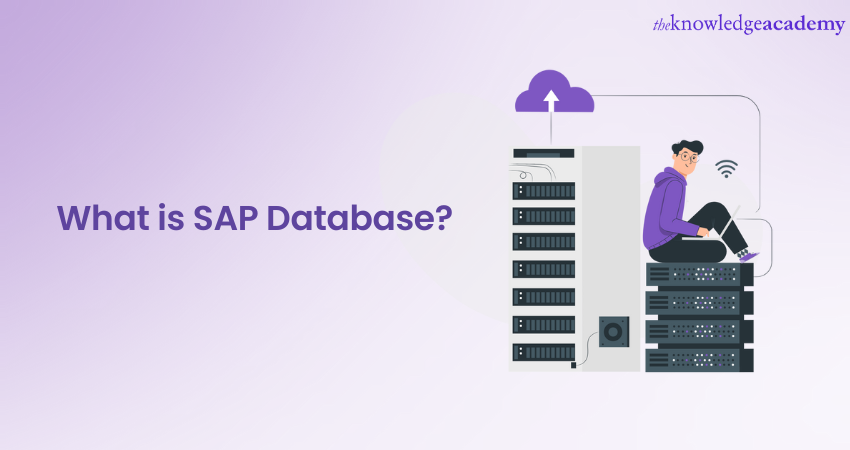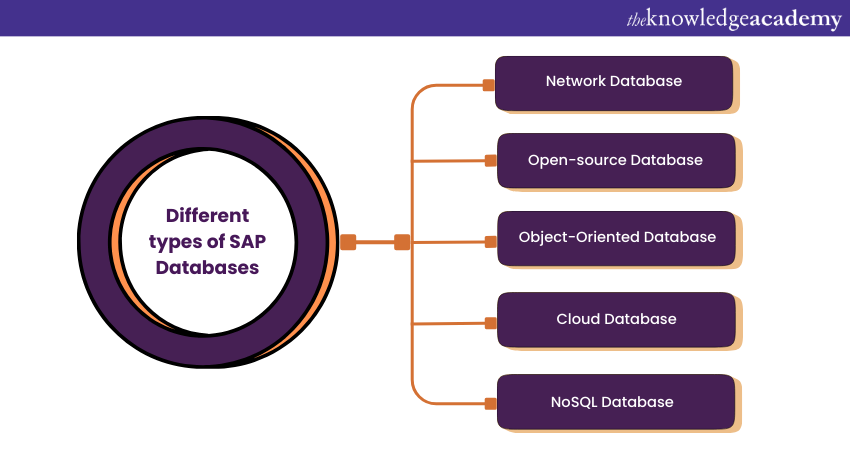We may not have the course you’re looking for. If you enquire or give us a call on +44 1344 203 999 and speak to our training experts, we may still be able to help with your training requirements.
Training Outcomes Within Your Budget!
We ensure quality, budget-alignment, and timely delivery by our expert instructors.

One of the ways by which a modern-day organisation adapts to digital transformation is by adapting automated Databases. One of the most relevant examples of a Database is a Systems, Applications & Products in Data Processing (SAP) Database. The SAP Database offers several benefits to an organisation over a traditional database, a factor that has led to its growing popularity.
In this blog, we will tell you all you need to know about an SAP Database with its examples as well as its different types. Read below to learn more!
Table of Contents
1) What does SAP Database mean?
2) SAP Database's background
3) What are the different types of SAP Databases?
4) What are some examples of SAP Databases?
5) Conclusion
What does SAP Database mean?
SAP Databases can be defined as an organised collection of structured data that helps facilitate OnLine Analytical Processing (OLAP) and OnLine Transition Processing (OLTP) for companies from different sectors. These companies belong to various sectors, such as banking, e-commerce, manufacturing, technology and healthcare. These Databases ensure that the data they store live up to the following features:
1) Accurate: This feature of the data ensures that the data does not have many errors and has no duplicate versions.
2) Complete: This feature of the data ensures that the data has no missing values.
3) Relevant: This feature of the data ensures that the data used for analysis is completely updated and relevant to the necessary context.
4) Conformant: This feature of the data ensures that the data follows a given set of rules and standardised formats that are defined as part of an organisation’s Data Management strategy process.
5) Consistent: This feature of the data ensures the uniformity and consistency of data as it is transferred between systems and applications.
6) Secure: This feature of the data ensures that it is secure from unauthorised attacks, data breaches or corruption.
SAP Database's background
As Databases have evolved over the course of time, they have branched into different categories based on the need of the user. The Database, which was limited to being a flat-file system has diverged into Relational and object-relational systems each having its respective use cases.
In its earliest generations, the Database system came with many Benefits of sap such as ordered data and a convenient method to store information. Originating in 1968 in a file-based system, its benefits were severely limited due to technological differences compared to the current era. Despite these limitations, it also had its fair share of benefits, some of them being the ability to ac cess the data sequentially, randomly or by indexing it.
The term SAP originated originally from the SAP Database Management System (DBMS). This Database is renowned for its platform-independent nature that has the features of both Oracle and Informix Databases. SAP Modules were capable of extensions similar to Oracle, while also possessing the advanced Database engine of Informix.
While being a query language, SAP Database often requires the aid of programming languages. In the current day and age, most people will think of programming languages like Python and Java when it comes to assisting SQL, however circumstances were different during the early years of SQL. A lot of third-generation programming languages like COBOL, and BASIC which predated C, were commonly used with Databases.
Learn all you need to know about SAP by signing up for our SAP Training Courses!
What are the different types of SAP Databases?
There are several types of SAP Databases, all of which we will explore in detail below:

Network Database
A Network Database consists of multiple member files or records linked to multiple owner files and vice versa. A Network Database provides multiple owners with various data access paths. The Database can be imagined as an upside-down tree, where the member information represents the branches leading to the owner at the bottom – and every fragment of data is eventually connected to the main data.
Network Databases allow more natural modelling of relationships between records and entities. It is also more flexible and accessible, which results in faster search, navigation and access to data. An example of a Network Database is SAP HANA, which consists of components that facilitate system communication with the help of Networking channels.
Open-source Database
An Open-source Database has a code that can be accessed publicly and is free to download, re-use and modify. This Database stores important information that organisations control. Users can use the Database to create their systems in accordance with their business requirements and modify the source code according to their preferences.
Users of Open-source Databases do not require any payment for using the code, unlike Commercial Databases, where users pay to use larger datasets or access additional features. These Databases are cost-effective and flexible to use. An example of such an Open-source Database is SAP MaxDB.
Object-oriented Database
Object-oriented Database Management Systems (OODBMS) make code easier to manage as they help integrate Database functionality into Object-oriented Programming languages. Such Object-oriented Databases incorporate Relational Database principles. An OODBMS is known to use the following:
1) Objects: Objects are building blocks of classes with either built-in or user-defined types.
2) Class: A class determines the behaviour of an object.
3) Methods: The methods of a class determine its behaviour.
4) Pointer: A pointer helps access elements of an object Database and establish relationships among objects.
Using Object-oriented Databases has several advantages. The advantages include transparency, easy retrieval, seamless integration and persistent storage. Users are allowed to store all the properties of data objects in the Database, and the Database continues to store them after the program terminates. Upon restarting the program, the Database can retrieve an object with the specified properties. This facilitates the storage and retrieval of complex data objects transparently.
Cloud Database
A Cloud Database can be defined as a Database hosted on a Cloud server which can be accessed through a web interface or Applicating Programming Interface (API). Much like traditional Databases, these Cloud Databases provide several functionalities. However, they facilitate secure data storage without the organisation investing in expensive hardware. Cloud Databases are known to support Relational Databases such as Structure Query Language (SQL) and NoSQL Databases such as MongoDB. Their common features include the following:
1) Scalability: This feature helps businesses easily manage large volumes of data without affecting the overall performance.
2) Elasticity: This feature means businesses can increase or decrease the number of data nodes per their specific requirement.
3) Security: This feature assures that the data stored in the Cloud is safe from any possible theft or unauthorised data breaches.
4) Redundancy: This feature means businesses can ensure their data despite server failures due to regular backups.
5) Manageability: This final feature means that IT teams can conveniently perform several administrative operations on the Database.
NoSQL Databases
NoSQL refers to all the Database technologies which do not use Simple Query Languages as the primary language while accessing data. These kinds of Databases are different from Relational Databases, as it does not require a predefined schema - a feature that makes them great for semi structured or unstructured data. These Databases are often referred to as Non-relational Databases. Some of its features include:
1) Modifiability: Programmers can modify the NoSQL Database in real time.
2) Integrity: Modifying data in this Database does not affect the applications.
3) Versatility: This Database can benefit from technologies like Apache Cassandra, MongoDB, CouchDB, and CouchBase.
Join our SAP Finance and Controlling FICO Training course and learn how SAP financials manage and represent accounting data.
What are some examples of SAP Databases?
Now that we have discussed what an SAP Database is as well as the types of SAP Databases, we will look at a few examples of SAP Databases now.
SAP HANA
SAP High-Performance Analytic Appliance (HANA) is a multi-model Database that facilitates using multiple data models using a single back-end. As with traditional Databases, an SAP HANA Database stores data in its memory rather than on a disk, which facilitates faster data access than Disk or Solid-State Drives (SSD).
The Database supports the search, analytics and integration of structured and unstructured data. It also helps develop smart, insight-driven applications through real-time data, in-memory computing and machine learning. One can access these features both on the Cloud and on-premises.
SAP IQ
SAP Intelligent Query (IQ) is a column-based, Relational Database system that facilitates Business Intelligence (BI), data warehousing and data marts. The two principal components of SAP IQ are clients and servers, both of which provide their own features to the Database. The client components provide connectivity, SQL command pursuing, authentication, monitoring and administration via the web. The server components provide features such as column stores, query engines, parallel data loading engines, Database encryption, authorisation and scalability.
SAP ASE
SAP Adaptive Server Enterprise (ASE) is a Relational Database server known to handle large volumes of data and users simultaneously. This feature of the SAP ASE Database ensures reliability, accessibility and performance across multiple industries. It also facilitates the processing of mission-critical transactions while maintaining high levels of performance and availability.
These Databases also possess flexible SQL systems that decrease risk and improve agility. The SAP ASE is also resource-efficient, meaning that it helps organisations lower their operational costs.
Oracle Runtime Database
Oracle Runtime Database is multi-platform document store which allows you to access data regardless of your device type and its Operating System (OS). This allows clients to work using different programming languages like Android, JavaScript, and iOS while using an instance of a Realtime Database.
Oracle Runtime Database is available for both mobile and website-based access. Additionally, it offers the benefit of being automatically updated with the latest data control features.
SAP MaxDB
SAP MaxDB Database is known for the consistent structure of its data. This is possible due to the application data and the metadata within the metadata having a unique name, allowing for consistent formatting.
Microsoft SQL Server
Microsoft SQL Server is one of the leading figures in the domain of Databases It is a Relational Database Management tool which is capable of supporting multiple applications. The usage of this server includes transaction, processing, and analysis.
IBM Db2
IBM Db2 is a collection of products, which is frequently used for Database Management. Db2 is one of the most popular AI- powered tools in this Database, capable of helping with both structured and unstructured Data Management. The Db2 range of tolls simplify the data handling process, by allowing you to take advantage of AI.
Conclusion
All in all, an SAP Database is a logically organised collection of structured data that helps facilitate OnLine Analytical Processing (OLAP) and OnLine Transition Processing (OLTP) for companies from different sectors. There are different types of SAP Databases like Network, Open-source, Object-oriented, Cloud Databases and NoSQL Databases– while some examples of SAP Databases are SAP HANA, SAP IQ and SAP ASE. Hope we could provided you with everything you needed to learn about SAP Databases!
Gain a comprehensive understanding of how SAP and Financial Accounting work by joining our SAP Financial Accounting Course !
Frequently Asked Questions
Upcoming Programming & DevOps Resources Batches & Dates
Date
 SAP Financial Accounting
SAP Financial Accounting
Fri 16th Aug 2024
Fri 15th Nov 2024









 Top Rated Course
Top Rated Course



 If you wish to make any changes to your course, please
If you wish to make any changes to your course, please


